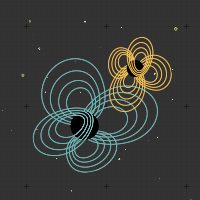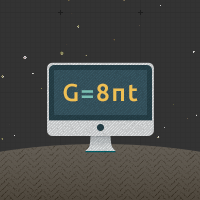Sources of Gravitational Waves
Stirring Up the Ripples
Gravitational waves, like the ones shown distorting the boat on the last page, pass through the Earth constantly. Every ship that ever plied the ocean has run into both water waves and gravitational waves. The only difference is that gravitational waves are typically so extraordinarily small in amplitude that it is nearly impossible to notice them.
One reason that the effects of gravitational waves are so small is that they get smaller the farther we are from their source. This is the same thing that we see with light. It's nearly impossible to look into a light bulb up close (and not recommended, unless you're trying to dodge a draft). But the light has to spread out over a much greater area when it shines far away, so its intensity must go down. From across the room, the light is much less bright and not painful at all. In just the same way, gravitational waves spread out when we are far away from them, and their amplitude goes down.
It turns out that nothing in the Solar System is good at creating big gravitational waves. No matter how close to the Earth-Sun "paddle" we get — even on it — we wouldn't notice the astoundingly miniscule waves coming out. There are two reasons for this. First, the curvature in the Solar System is never very large because gravity really isn't all that strong in our neighborhood. This means that the curvature can't change by much. Second, it doesn't change very quickly when things move on time scales like a month or a year. To produce gravitational waves with large amplitudes, an object must produce a lot of quickly-changing curvature. Everything in the Solar System is too soft, too weak, and too slow to do this. Astrophysicists have, however, discovered other things in the distant Universe capable of giving off gravitational waves intense enough to be measured on Earth.
Take a look through the below links to learn more about sources of gravitational waves, like white dwarfs, black holes, and even the Big Bang.
- Compact Objects
- The First Moments
- Exotic Possibilities
- The Unknown






